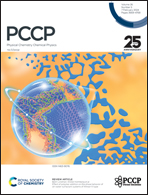Excited state hydrogen or proton transfer pathways in microsolvated n-cyanoindole fluorescent probes†
Abstract
The sensitivity of the fluorescence properties of n-cyanoindole (n-CNI) fluorescent probes to the microenvironment makes them potential reporters of protein conformation and hydration. The fluorescence intensity of 5-CNI, 6-CNI, and 7-CNI is quenched when exposed to water solvent whereas substitution on position 4 of indoles dramatically increases it. A potential mechanism for this sensitivity to water may be similar to that found in indole. The fluorescence of indole is found to be quenched when interacting with water and ammonia solvent molecules via radiationless decay through an S1 (πσ*)/S0 conical intersection caused by excited state proton or hydrogen transfer to the solvent molecules. In this study we examine this fluorescence quenching mechanism along the N–H bond stretch of n-CNI probes using water cluster models and quantum mechanical calculations of the excited states. We find that n-CNI–(H2O)1−2 clusters form cyclic or non-cyclic structures via hydrogen bonds which lead to different photochemical reaction paths that can potentially quench the fluorescence by undergoing internal conversion from S1 to S0. However, the existence of a high energy barrier along the potential energy surface of the S1 state in most cases prevents this from occurring. We show that substitution on position 4 leads to the highest energy barrier that prevents the fluorophore from accessing these non-radiative channels, in agreement with its high intensity. We also find that the energy barrier in the S1 state of non-cyclic 5-CNI–(H2O)1−2 excited complexes decreases as the number of water molecules increases, which suggests great sensitivity of the fluorescence quenching on the aqueous environment.

- This article is part of the themed collection: PCCP 25th Anniversary Issue


 Please wait while we load your content...
Please wait while we load your content...
